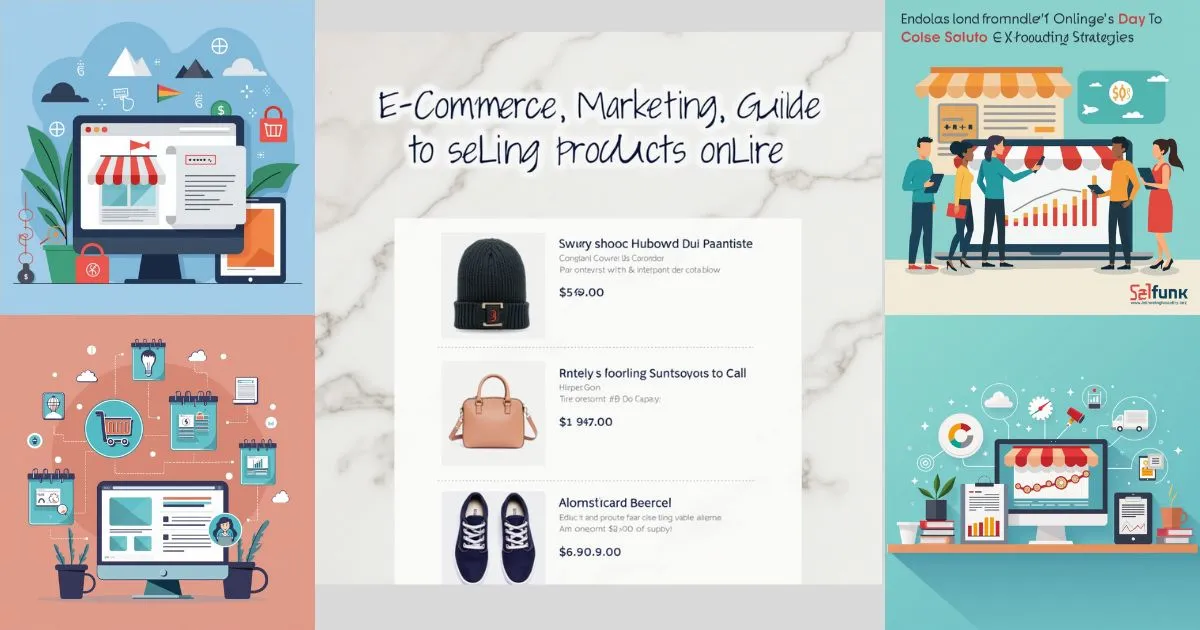Thinking about online shopping, I see how key e-commerce marketing is today. The U.S. is expected to see more digital buyers, from 263 million in 2021 to 291.2 million by 2025. A strong online presence is vital for businesses to thrive. Good e-commerce marketing, like digital marketing and improving conversion rates, helps reach and sell to more people.

As a business owner, I know how important keeping customers is. E-commerce marketing helps build strong customer ties. Using online tactics, like social media and email marketing, boosts customer loyalty. This guide will cover the basics of e-commerce marketing and offer tips for success.
Table of Contents
Key Takeaways
- Developing a strong e-commerce marketing strategy is essential for online success
- Digital marketing and conversion rate optimization can help drive sales and revenue
- Customer retention is critical for long-term success, and e-commerce marketing can help build strong relationships with customers
- Online business strategies, such as social media marketing and email marketing, can increase customer engagement and loyalty
- Optimizing your online store with e-commerce marketing strategies can help you stay competitive in the market
- Understanding your target audience and their needs is crucial for effective e-commerce marketing
Understanding E-Commerce Marketing Fundamentals
To succeed in e-commerce, you need to know the basics. This includes having a great product, a good website, and solid marketing. A strong online presence is key, and setting goals and KPIs helps guide your strategy.
Building a strong online presence is crucial. A user-friendly website and effective marketing strategies are essential. Personalization is important, with 60% of consumers preferring personalized experiences. Knowing your target audience well is also vital for a successful online store.
Key Components of Digital Retail Success
Digital retail success depends on several key areas. These include a well-designed website, effective marketing, and efficient shipping. Understanding your audience and setting measurable goals and KPIs are crucial for success.
Building Your Online Presence
Creating a strong online presence means having a user-friendly website and effective marketing. This includes SEO, pay-per-click ads, and social media marketing. These strategies can boost your online visibility and sales.
Setting Marketing Goals and KPIs
Setting marketing goals and KPIs is vital for measuring success. Metrics like website traffic, conversion rates, and customer retention are important. Tracking these KPIs helps refine your marketing strategy and improve results.
Some key e-commerce marketing fundamentals to consider include:
- Developing a strong online presence through effective website design and marketing
- Understanding your target audience and creating personalized experiences
- Setting measurable marketing goals and KPIs to guide your strategy
- Leveraging SEO, pay-per-click advertising, and social media marketing to drive sales

By understanding and applying these e-commerce marketing fundamentals, you can set your online store up for success. Stay focused on your marketing goals and KPIs, and keep refining your strategy to get better results.
| E-commerce Marketing Strategy | Benefits |
|---|---|
| Search Engine Optimization (SEO) | Increased online visibility, higher conversion rates |
| Pay-per-Click Advertising | Targeted traffic, increased brand awareness |
| Social Media Marketing | Increased engagement, improved customer retention |
Essential Digital Marketing Channels for Online Stores
As an online store owner, it’s key to know the value of digital marketing channels. They help reach customers and boost sales. With over 5 billion active users, social media marketing is a strong tool for brand awareness and engaging with customers. Also, email marketing offers a high return on investment, with an average of $42 for every $1 spent.
Search engine optimization (SEO) is another vital digital marketing channel. It can cut down on marketing costs by up to 70%. About 45.1% of all search clicks come from organic results, making SEO crucial. Marketers also find SEO more effective than pay-per-click (PPC) for sales.

To get the most out of these digital marketing channels, online stores need a strong online presence. They should use social media marketing, email marketing, and search engine optimization to reach their audience. This approach can boost brand awareness, drive sales, and keep them competitive.
| Digital Marketing Channel | Benefits |
|---|---|
| Social Media Marketing | Brand awareness, customer engagement, cost-effective |
| Email Marketing | High ROI, cost-effective, targeted marketing |
| Search Engine Optimization (SEO) | Increased organic traffic, reduced marketing costs, improved sales |
Mastering Social Media Marketing for E-Commerce
As an e-commerce owner, I know how key social media marketing is. It helps reach customers and boost sales. With 3.6 billion people using social media, it’s clear why 54% look at products before buying.
Being active on Instagram, TikTok, Facebook, and Pinterest is essential. This helps businesses connect with their audience and grow sales. Instagram, for example, has a 1.08% conversion rate for e-commerce, higher than most websites.
Creating engaging content and talking to customers on social media is crucial. It boosts brand awareness and sales. For instance, 71% of people are likely to buy something based on social media recommendations.
Effective Social Media Strategies
To excel in social media marketing, consider these strategies:
- Use customer content to engage and sell more
- Partner with influencers to reach more people and grow your brand
- Advertise on social media to get more site traffic and sales
- Post often to keep your brand in the conversation and build a community
By using these strategies and keeping a strong social media presence, e-commerce businesses can grow. They can increase brand exposure, sales, and stay competitive. Keeping up with social media trends and best practices is key to success in e-commerce.
| Platform | Conversion Rate | Monthly Active Users |
|---|---|---|
| 1.08% | 1.2 billion | |
| TikTok | 0.54% | 655.9 million |
| 0.77% | 2.7 billion | |
| 0.52% | 322 million |
Search Engine Optimization for Online Retailers
As an online retailer, I know how key search engine optimization (SEO) is. Most online shoppers use search engines to find what they need. So, it’s vital to know about SEO and keyword research. Only 0.63% of searchers click on websites on Google’s second page, showing the need to rank high.
To boost my website’s visibility, I focus on keyword research. I look for search terms that match my products. I also work on on-page optimization by making my content high-quality and relevant. Plus, I use internal links to help pages rank better.
Some important SEO strategies for online retailers include:
- Doing thorough keyword research to find the right search terms
- Optimizing product descriptions and meta tags with target keywords
- Creating engaging content to keep customers interested
- Getting backlinks from trusted sources to boost website authority
By using these SEO strategies, online retailers can get more traffic and sales. As search engine optimization keeps changing, it’s crucial to keep up with new trends and best practices.
Regular checks on technical SEO, like site structure and content duplication, can really help a site rank better. By focusing on SEO and doing good keyword research and on-page optimization, online retailers can grow their online presence and boost sales.
| SEO Strategy | Benefits |
|---|---|
| Keyword Research | Find valuable search terms, make website more visible |
| On-Page Optimization | Help website rank higher, bring in more traffic |
| Internal Linking | Share authority between pages, improve overall rankings |
Paid Advertising Strategies That Drive Sales
As an e-commerce business owner, I know how crucial paid advertising is. It helps drive sales and reach customers. With over $1.65 trillion spent on ads in 2023, it’s clear businesses are investing big in paid advertising to stay ahead.
In the United States, big e-commerce stores spent $3.5 billion on ads in 2023. This shows how important paid advertising is for e-commerce. To get the most out of paid advertising, using Google Ads and shopping campaigns is key to reaching your audience.
Some top strategies for paid advertising include:
- Social media advertising to engage with customers and boost sales
- Retargeting and remarketing to catch users who didn’t buy the first time
By using these strategies in their paid advertising campaigns, businesses can boost their online presence. They can drive sales and stay competitive.
| Advertising Channel | Investment | Return on Investment (ROI) |
|---|---|---|
| Google Ads | $1.5 billion | 20% increase in sales |
| Social Media Advertising | $1 billion | 15% increase in website traffic |
Customer Retention and Loyalty Programs
As an e-commerce business owner, I know how vital customer retention and loyalty programs are. With e-commerce sales expected to hit 24.5% by 2025, keeping customers loyal is key.
Some important stats show the power of customer loyalty:
- 84% of customers prefer brands with loyalty programs.
- 63% of people are ready to pay more for brands they love.
- 80% of loyal shoppers only buy from brands that get them.
To make great loyalty programs, think about personalized and timely marketing. Offer rewards, special discounts, and products just for them. This boosts customer retention and helps your profits.
By focusing on customer retention and loyalty programs, e-commerce can grow and earn more. It’s important to always check and better your retention strategies. This way, you meet your customers’ changing needs and stay ahead in the market.
Advanced E-Commerce Marketing Automation
As an e-commerce business owner, I know how key e-commerce marketing automation is. It boosts sales and revenue. Using email marketing automation, chatbot implementation, and personalization strategies makes marketing smoother. It also enhances customer interaction.
E-commerce marketing automation offers many benefits. It helps keep customers, lowers cart abandonment, and increases sales and ROI. For example, Remix saw a 104% jump in first-time purchases with automated emails. Marks & Spencer recovered 15.1% of carts with push notifications.
To use advanced e-commerce marketing automation, look at these tools and their prices:
- HubSpot: $890/month (professional) and $3600/month (enterprise)
- Drip: starting at $39/month
- Sender: free forever plan, $10/month (standard), and $20/month (professional)
- Omnisend: free plan, $11.20/month (standard), and $41.30/month (pro)
Investing in e-commerce marketing automation and using email marketing automation, chatbot implementation, and personalization strategies helps businesses grow. It keeps them competitive and drives long-term success.
Analytics and Performance Tracking
As an e-commerce owner, tracking your website’s performance is key to boosting sales and revenue. Analytics helps you understand what your customers like and do. Tools like Google Analytics let you keep an eye on important stats like conversion rate and average order value.
Good performance tracking means setting goals and KPIs. This includes conversion rate optimization and ROI measurement. It helps you spot where to improve and make smart marketing choices.
- Conversion rate: the percentage of website visitors who make a purchase
- Average order value: the average amount customers spend per order
- Customer lifetime value: the total value of a customer over their lifetime
By watching these metrics and using Google Analytics to guide your choices, you can make your e-commerce business better. This will help you see a better ROI measurement.
| Metric | Definition | Importance |
|---|---|---|
| Conversion Rate | The percentage of website visitors who make a purchase | High |
| Average Order Value | The average amount customers spend per order | Medium |
| Customer Lifetime Value | The total value of a customer over their lifetime | High |
Conclusion: Taking Your E-Commerce Business to the Next Level
To take your e-commerce business to the next level, you need a solid plan. Use the marketing strategies and techniques from this guide to grow your sales and keep customers coming back. Success online comes from combining many things, like social media, SEO, and ads.
Keep improving your online look, make your website better for sales, and use data to make smart choices. This will help your e-commerce business succeed for a long time. The e-commerce market changes fast, and those who stay up-to-date will do well.
When you start working on your e-commerce growth strategies, be quick to change, try new things, and always learn more. There are many ways to grow, and with the right approach, your online business can soar.
FAQ
What is e-commerce marketing and why is it important?
E-commerce marketing is about promoting and selling online. It’s key as more people shop online. A strong online presence and good digital marketing help businesses grow and keep customers loyal.
What are the key components of digital retail success?
Success in digital retail means having a strong online presence. You need clear goals and to know your audience. A good website, SEO, and using digital marketing channels are also crucial.
What are the essential digital marketing channels for online stores?
Key channels for online stores are social media, email marketing, and SEO. These help reach and convert customers. They drive traffic to your site.
How can I master social media marketing for e-commerce?
Mastering social media for e-commerce means creating engaging content. Use platforms like Instagram and Facebook. Interacting with customers and offering personalized experiences strengthens your brand.
How can I optimize my website for search engines?
To optimize your website, focus on keyword research and on-page optimization. Use relevant keywords and optimize your page titles. Building quality backlinks also helps improve visibility.
What are the most effective paid advertising strategies for e-commerce?
Effective paid ads for e-commerce include Google Ads and social media ads. Retargeting also works well. These strategies help reach and convert your target audience.
How can I improve customer retention and build loyalty programs?
Improve retention by creating personalized experiences and offering rewards. Use loyalty programs and email campaigns. Great customer service keeps customers coming back.
What are some advanced e-commerce marketing automation strategies?
Advanced strategies include email automation and chatbot use. Personalization also boosts engagement and sales. These methods make marketing more efficient and effective.
How can I effectively track and analyze the performance of my e-commerce marketing efforts?
Use tools like Google Analytics to track your marketing. Focus on KPIs and use data to improve strategies. This helps drive better results for your online business.

